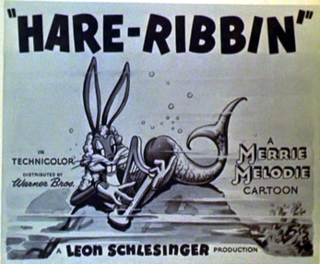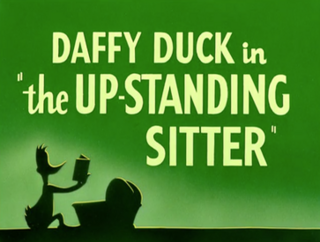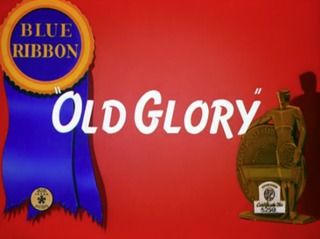
Porky in Wackyland is a 1938 Warner Bros. Looney Tunes animated short film, directed by Bob Clampett. The short was released on September 24, 1938, and stars Porky Pig venturing out to find the last do-do bird, which he finds in Wackyland, a land that makes no sense located in Darkest Africa.
This is a listing of the shorts, feature films, television programs, and television specials in the Looney Tunes and Merrie Melodies cartoon series, extending from 1929 through the present day. Altogether, 1,002 animated shorts alone were released under the Looney Tunes and Merrie Melodies banners from the 1930s through the 1960s. From the beginning to the present day, 1,041 theatrical shorts have been created.
Charlie Dog is an animated cartoon character in the Warner Brothers Looney Tunes series of cartoons. The character was featured in nine cartoons between 1941 and 1958. He is generally characterized as a friendly wise guy.
Spike the Bulldog and Chester the Terrier are animated cartoon characters in the Warner Bros. Looney Tunes and Merrie Melodies series of cartoons. Spike is a burly, gray bulldog wearing a red sweater, a brown bowler hat, and a perpetual scowl. Chester is a Jack Russell terrier who is just the opposite, small and jumpy with yellow fur and brown, perky ears.

Bugsy and Mugsy is a 1957 Warner Bros. Looney Tunes cartoon directed by Friz Freleng. The short was released on August 31, 1957, and stars Bugs Bunny, with Rocky and Mugsy. Bugs discovers that two robbers are hiding out on the floor above him, and plays them off against each other. The cartoon is a remake of the 1950 Merrie Melodies short Stooge for a Mouse, in which a mouse pitted Sylvester and Mike against each other in the same way.

Piggy is the name of two animated cartoon characters in the Merrie Melodies series of films distributed by Warner Bros. The first character was a fat, black pig wearing a pair of shorts with two large buttons in the front, and his first film was You Don't Know What You're Doin'!

I Love to Singa is a 1936 Warner Bros. Merrie Melodies animated cartoon directed by Tex Avery. The short was released on July 18, 1936.

Babbit and Catstello are fictional characters, based on the comedic duo Abbott and Costello, that appeared in Warner Bros. animated cartoons. The characters appeared in four cartoons between 1942 and 1946: once as cats, once as dogs, and twice as mice.

Hare Ribbin' is a 1944 animated short film in the Merrie Melodies series, directed by Robert Clampett and featuring Bugs Bunny. The plot features Bugs' conflict with a red-haired hound dog, whom the rabbit sets out to evade and make a fool of using one-liners, reverse psychology, disguises and other tricks. It was released in theaters by Warner Bros. on June 24, 1944. The title is a pun on "hair ribbon".
Don't Look Now is a 1936 Warner Bros. Merrie Melodies animated short film directed by Tex Avery. The short was released on November 7, 1936.
Of Fox and Hounds is a 1940 Warner Bros. Merrie Melodies directed by Tex Avery. The short was released on December 7, 1940, and introduces Willoughby the Dog. Avery performed the voice of Willoughby, and Mel Blanc voiced George the Fox and the bear's yells. The short is an attempt to duplicate the success of the 1940 Bugs Bunny short A Wild Hare by giving another anthropomorphic animal the same unflappable demeanor. The names of Tex Avery, Dave Monohan, Carl W. Stalling, and possibly Charles McKimson intentionally draft numbers in the credits.

The Up-Standing Sitter is a 1948 Warner Bros. Looney Tunes cartoon, directed by Robert McKimson. The cartoon was released on July 3, 1948, and stars Daffy Duck. All voices are by Mel Blanc.
This is a listing of all the animated shorts released by Warner Bros. under the Looney Tunes and Merrie Melodies banners between 1940 and 1949.

Old Glory is a 1939 Warner Bros. Merrie Melodies animated cartoon directed by Chuck Jones. The short was released on July 1, 1939, and stars Porky Pig. The cartoon was commissioned by Warner Bros. as a counterpart for a series of live-action films about American patriotism.

Cinderella Meets Fella is a 1938 Warner Bros. Merrie Melodies directed by Tex Avery and written by Tedd Pierce, based on the fairy tale of Cinderella. The short was released on July 23, 1938, and features the third appearance of an early version of Elmer Fudd.

The Penguin Parade is a 1938 Warner Bros. Merrie Melodies directed by Tex Avery. The short was released on April 23, 1938.
Don't Axe Me is a 1958 Warner Bros. Merrie Melodies cartoon directed by Robert McKimson. The short was released on January 4, 1958, and stars Daffy Duck, Elmer Fudd and Barnyard Dawg.
I Wanna Play House is a 1936 Warner Bros. Merrie Melodies cartoon directed by Friz Freleng. The short was released on January 11, 1936.
Detouring America is a 1939 Warner Bros. Merrie Melodies cartoon directed by Tex Avery. The short was released on August 26, 1939.










